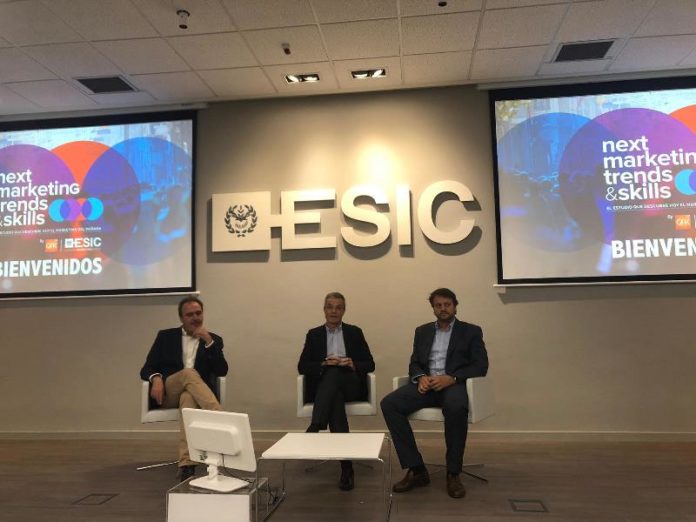At this time, marketing managers must manage a large number of changes very quickly. According to the study “Next Marketing Trends & Skills”, developed jointly by ESIC and GfK, the consumer and its relationship with brands has changed, thanks to new technological tools, with the mobile as the spearhead. The distribution and sales channels have multiplied; there are new means and forms of communication; competitors have appeared in unsuspected places and the best references are in sectors other than their own. We are without a doubt, before an intense moment, convulsed and in full transformation.
However, as specified in the report, the fundamentals of marketing remain the basis on which everything is planned, executed and measured. For the Marketing directors that have participated in the project, there is consensus on this: everything has changed, except marketing’s final objective – to build the brand and support sales.
The study, developed jointly by ESIC and GfK, aims to understand the vision of the Marketing Directors regarding the current situation of marketing in Spain, the trends that will mark the next years and the professional profile necessary to face this new reality.
In the first phase of the study 7 focus groups were carried out, in which 26 marketing directors from different companies and sectors participated, such as AXA, BBVA, CHEP, COCA-COLA, COMESS GROUP, DIARIO AS, FOX ENTERTAINMENT, FUTBOLFACTORY, BEL GROUP , HYUNDAI, IBERDROLA, IBERIA, INFINITI, THE LEAGUE, SAMSUNG, SEGUROS PELAYO, ATRAPALO.COM, BON PREU, CINESA (AN AMC COMPANY), CODORNIU, DIVINA PASTORA SEGUROS, LABORATORIOS BABÉ, THE PROVINCES (VOCENTO), PROFILTEK, VALENCIA SOCCER CLUB, SOROLLA GROUP.
The second phase of the study sought to measure the previous findings, through 1,040 online interviews conducted among marketing professionals from all over the country, in a representative sample of the business fabric of Spain. 40% of those consulted have a managerial level, while 23% work in middle management. One in four has more than 20 years of work experience and 47% between 6 and 20 years. Half have received education at the Master’s level. All this contributes to a highly qualified professional sample.
A powerful and superindividual consumer
The consumer today interacts with brands one-on-one, is more demanding, dynamic, impatient, is more informed and has been super-individualized. Today’s marketing professionals are faced with a very active consumer who sees himself/herself as possessing the power to bend brands, thanks to the amplifying effect that social networks provide. He is a ruthless and unfaithful client, who looks for immediate experiences.
Therefore, as the study points out, it is key to create personalized campaigns where the focus is not the product or service, but the consumer and their particular experience with the category and with the brand that wishes to gain their preference. For this reason, 78% of those consulted opt for individualized and emotional communication.
The previous paradigms where the objective was to know the customer, anticipate and satisfy their wishes or needs have been obsolete in the opinion of almost 20%, for whom the important thing today is to detect trends early and see how they affect or influence your own brand or category.
Changes in the consumer accelerate the adjustment of strategies in brands
The transformation of the consumer has its origin in the digitalization of society, in particular, in the development and the great penetration of smartphones and their enormous capacity for connectivity. The use of mobile devices has produced changes in all areas, also in consumer behavior and, therefore, in its relationship with brands.
Mobile technology has made life easier for consumers, but it means an accelerated internal re-adaptation in marketing departments. They have had to experiment and learn from trial and error and also to be trained in the new reality. For many of those responsible for marketing, the current use of mobile phones by customers and consumers, although it generates a large amount of information, also makes it difficult to analyze trends.
One of the participating directors in the focus groups phase warned: “Risk and innovation are fundamental. If you want to draw attention in a saturated environment, you have to go ahead. You must be well trained and informed on the digitalization. The mobiles are 10-15 years old and today we all think that we have been with them all our lives.”
It has also lead to the classifications between on and off, traditional marketing versus digital marketing. Today, according to 67% of those consulted, we must talk about marketing in the digital age, which implies a global, risky, innovative and 360-degree vision.
When thinking about the current channels and points of sale, 41% prefer to be present in all distribution channels, while 36% prefer to select a channel and position itself in it.
Communicating with the current consumer also means listening; there is no need to advertise; now we have to generate stories, something that 74% of the interviewees agree with.
The speed of the changes has been tremendous, but it will go further, since 60% of the marketing professionals participating in the study believe that they should accelerate the launch of new products and services, in order to respond to market demands. However, there are those who recommend lowering the pace of innovations, as they may be producing a counterproductive effect: the consumer is being overwhelmed and is not being given time to know, assimilate and adopt the brand’s new products and services. GfK’s recommendation in this regard is: “The more disruptive the innovation, the more patience there has to be for the process of adoption of the final consumer.”
Another interesting finding has been that there are fewer and fewer boundaries between sectors, which gives rise to new competitors in other industries, according to 74% of respondents.
The brand, on the other hand, has ceased to be a monopoly of the Marketing department, according to 75% of those consulted, today it is everyone’s responsibility in the companies.





